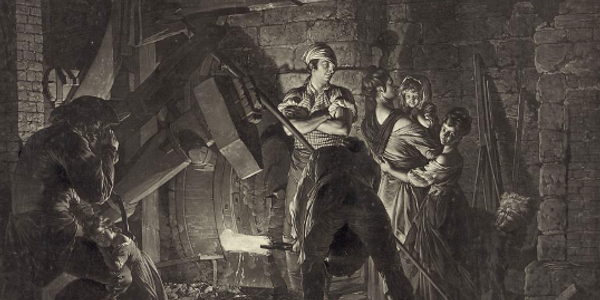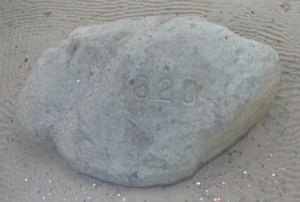Sponsor this page for $150 per year. Your banner or text ad can fill the space above.
Click here to Sponsor the page and how to reserve your ad.
-
Timeline
1752 Detail
June 15, 1752 - Benjamin Franklin invents the lightning rod after earlier in the year proving that lightning was electricity by flying a kite in a thunderstorm.

Forty-six years old with a mind charged with so many ideas, both literary, scientific, and political, that the task of running the largest colonial newspaper, the Pennsylvania Gazette, and other magazines, was not nearly enough for his inventiveness, i.e. bifocals, etc. By 1746, he was becoming very interested in scientific experiements and storms. While in Boston, he visited scientific colleagues who were experimenting with currents, electricity, and built a laboratory in his own home to do the same. One day, he shocked himself.
"... a universal blow throughout my whole body from head to foot, which seemed within as well as without; after which the first thing I took noticed of was a violent quick shaking of my body..," Ben Franklin, Franklin Institute.
It was in July 1747 that Franklin began using the terms positive and negative to describe the phenomenom while engaging in experiments. Within two years, he thought that electricity and lightning were similar, if not actually electricity, a concept other scientists agreed with. Franklin wanted proof. He also wanted protection, thinking that a lightning rod could protect buildings from their strikes and minimize damage.
Franklin and His Kite
It was not intended to be a kite, but the construction of the steeple on Christ Church in Philadelphia was going too slow for him to wait for its use as a lightning rod. So in 1752, he wrapped his hands in silk ribbon for insulation, attached a key to the end of a kite, and waited for a bad storm. Ben was not injured, stopping the experiment once he saw the first charges, and stood on an insulator. His son William, twenty-one, was the only witness. Surprisingly, Franklin, himself, never wrote about that experiment. Its story waited fifteen years before someone else brought it to light.
Franklin was not the only scientist working on these theories; on May 10, 1752, naturalist Thomas-Francois Dalibard instructed a retired dragoon to construct a tall iron rod insulated into the ground, and drew sparks from a violent lightning storm over the French village of Marly-la-Ville. Dalibard and colleague Delor had been following the procedure Franklin had already described, however, their experiment actually was conducted three days prior to Franklin and his kite. Some contend Franklin's date was June 15, although that could more likely be confused with the date given to his invention of the lightning rod itself. They, the French scientists, also continued to experiment with his suggested sentry-box experiment, showing the outcome to King Louis XV.
Franklin had, even before the kite experiment, thought that a metal rod high on a building could draw lightning toward it.
"May not the knowledge of this power of points be of use to mankind, in preserving houses, churches, ships, etc., from the stroke of lightning, by directing us to fix, on the highest parts of those edifices, upright rods of iron made sharp as a needle ... Would not these pointed rods probably draw the electrical fire silently out of a cloud before it came nigh enough to strike, and thereby secure us from that most sudden and terrible mischief!" Ben Franklin, Franklin Institute.
Franklin preferred his lightning rods with sharp points; others thought blunt would do better. King George III agreed with the others, placing a blunt rod on the royal palace. In the colonies they used Franklin's method; the crown thought this was just another way the colonists were being disobedient.
Franklin's Thoughts and Impact
... practical advice against taking shelter under an isolated tree during a thunderstom and that crouching in an open field was less dangerous.
In 1753, Royal Society of London awarded Benjamin Franklin their highest scientific honor, the Copley Gold Medal.
Franklin took the success of the sentry-box experiment in France and placed an insulated lightning rod on his house to study the effects of a thunderstorm. A conductor ran down a stairwell to ground with a gap in the middle attached to a ball with chimes on each side. When an electrified cloud passed over the house, the chimes rang.
Following the experiments on Franklin's own house in Philadelphia, lightning rods were installed on the Academy of Philadelphia (University of Pennsylvania), and the Pennsylvania State House, Independence Hall, in 1752.
Image above: Montage (left) Painting of Ben Franklin, circa 1785, Joseph-Siffred Duplessis. Courtesy National Portrait Gallery via Wikipedia Commons; (right) "The Philosopher and His Kite," 1840's, Engraver Henry S. Sadd, John Ludlow Morton, the Columbian Magazine. Courtesy Library of Congress. Image Below: Building in Philadelphia that housed the Pennsylvania Gazette owned by Ben Franklin, 2013, Carol M. Highsmith. Courtesy Library of Congress. Info Source: Franklin Institute; "Ben Franklin and Lightning Rods," 2006, Philip Krider, https://physicstoday.scitation.org/; Wikipedia Commons.

History Photo Bomb

Forty-six years old with a mind charged with so many ideas, both literary, scientific, and political, that the task of running the largest colonial newspaper, the Pennsylvania Gazette, and other magazines, was not nearly enough for his inventiveness, i.e. bifocals, etc. By 1746, he was becoming very interested in scientific experiements and storms. While in Boston, he visited scientific colleagues who were experimenting with currents, electricity, and built a laboratory in his own home to do the same. One day, he shocked himself.
"... a universal blow throughout my whole body from head to foot, which seemed within as well as without; after which the first thing I took noticed of was a violent quick shaking of my body..," Ben Franklin, Franklin Institute.
It was in July 1747 that Franklin began using the terms positive and negative to describe the phenomenom while engaging in experiments. Within two years, he thought that electricity and lightning were similar, if not actually electricity, a concept other scientists agreed with. Franklin wanted proof. He also wanted protection, thinking that a lightning rod could protect buildings from their strikes and minimize damage.
Franklin and His Kite
It was not intended to be a kite, but the construction of the steeple on Christ Church in Philadelphia was going too slow for him to wait for its use as a lightning rod. So in 1752, he wrapped his hands in silk ribbon for insulation, attached a key to the end of a kite, and waited for a bad storm. Ben was not injured, stopping the experiment once he saw the first charges, and stood on an insulator. His son William, twenty-one, was the only witness. Surprisingly, Franklin, himself, never wrote about that experiment. Its story waited fifteen years before someone else brought it to light.
Franklin was not the only scientist working on these theories; on May 10, 1752, naturalist Thomas-Francois Dalibard instructed a retired dragoon to construct a tall iron rod insulated into the ground, and drew sparks from a violent lightning storm over the French village of Marly-la-Ville. Dalibard and colleague Delor had been following the procedure Franklin had already described, however, their experiment actually was conducted three days prior to Franklin and his kite. Some contend Franklin's date was June 15, although that could more likely be confused with the date given to his invention of the lightning rod itself. They, the French scientists, also continued to experiment with his suggested sentry-box experiment, showing the outcome to King Louis XV.
Franklin had, even before the kite experiment, thought that a metal rod high on a building could draw lightning toward it.
"May not the knowledge of this power of points be of use to mankind, in preserving houses, churches, ships, etc., from the stroke of lightning, by directing us to fix, on the highest parts of those edifices, upright rods of iron made sharp as a needle ... Would not these pointed rods probably draw the electrical fire silently out of a cloud before it came nigh enough to strike, and thereby secure us from that most sudden and terrible mischief!" Ben Franklin, Franklin Institute.
Franklin preferred his lightning rods with sharp points; others thought blunt would do better. King George III agreed with the others, placing a blunt rod on the royal palace. In the colonies they used Franklin's method; the crown thought this was just another way the colonists were being disobedient.
Franklin's Thoughts and Impact
... practical advice against taking shelter under an isolated tree during a thunderstom and that crouching in an open field was less dangerous.
In 1753, Royal Society of London awarded Benjamin Franklin their highest scientific honor, the Copley Gold Medal.
Franklin took the success of the sentry-box experiment in France and placed an insulated lightning rod on his house to study the effects of a thunderstorm. A conductor ran down a stairwell to ground with a gap in the middle attached to a ball with chimes on each side. When an electrified cloud passed over the house, the chimes rang.
Following the experiments on Franklin's own house in Philadelphia, lightning rods were installed on the Academy of Philadelphia (University of Pennsylvania), and the Pennsylvania State House, Independence Hall, in 1752.
Image above: Montage (left) Painting of Ben Franklin, circa 1785, Joseph-Siffred Duplessis. Courtesy National Portrait Gallery via Wikipedia Commons; (right) "The Philosopher and His Kite," 1840's, Engraver Henry S. Sadd, John Ludlow Morton, the Columbian Magazine. Courtesy Library of Congress. Image Below: Building in Philadelphia that housed the Pennsylvania Gazette owned by Ben Franklin, 2013, Carol M. Highsmith. Courtesy Library of Congress. Info Source: Franklin Institute; "Ben Franklin and Lightning Rods," 2006, Philip Krider, https://physicstoday.scitation.org/; Wikipedia Commons.









